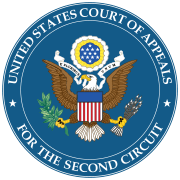American Geophysical Union v. Texaco, Inc.
American Geophysical Union v. Texaco, 60 F.3d 913 (2d Cir. 1995),[1] was a U.S. copyright case holding that a private, for-profit corporate library could not rely on fair use in systematically making copies of articles for its employees.[2]
| American Geophysical Union v. Texaco, Inc. | |
|---|---|
 | |
| Court | United States Court of Appeals for the Second Circuit |
| Argued | May 20, 1993 |
| Decided | October 28, 1994 |
| Citation(s) | 60 F.3d 913; 1995 Copr.L.Dec. (CCH) ¶ 27,417, 35 U.S.P.Q.2d 1513 |
| Case history | |
| Subsequent action(s) | Amended December 23, 1994; further amended July 17, 1995. |
| Court membership | |
| Judge(s) sitting | Jon O. Newman, Ralph K. Winter Jr., Dennis Jacobs |
| Case opinions | |
| Majority | Newman, joined by Winter |
| Dissent | Jacobs |
Case background
Texaco is a for-profit corporation that maintained an internal library and employed a number of scientists. Texaco subscribed to journals published by the American Geophysical Union, a scholarly society that publishes a number of journals. Texaco also purchased a photocopy license from the Copyright Clearance Center (CCC), an entity that licenses academic content to research organizations.[3] Texaco, like many entities with institutional libraries, engaged in the practice of photocopying articles from journals to send to employees.
The AGU and five other publishers, eventually joined by several dozen other publishers, sued Texaco.[3] Texaco defended its actions by citing the fair use doctrine, which holds that uses found to be "fair," "for purposes such as criticism, comment, news reporting, teaching (including multiple copies for classroom use), scholarship, or research," are not infringements of copyright.[4]
The court ultimately deemed Texaco's use not to be fair use; Texaco was fined and agreed to retroactively purchase a license from the Copyright Clearance Center.[1][5]
The Second Circuit's fair-use analysis weighed heavily on the "fourth factor",[3] which considers "the effect of the use upon the potential market for ... the copyrighted work."[4] Because CCC made licenses available for the photocopying, the court held that Texaco's failure to use those licenses for all its photocopying deprived the rightsholders of lost licensing revenue.[3] This portion of the opinion has been criticized for its circularity of reasoning: Since any use could in theory be licensed, any unlicensed use would weigh against fair use on the market harm factor.[2]
Judge Dennis Jacobs dissented. He characterized the publishers' argument as circular. Since any license fee they would collect would result only if the use was not deemed fair, deeming the use unfair because of the lost licensing fee was bootstrapping. He also would have treated the scientists' use of photocopies in the laboratory as socially productive and therefore weighing in favor of fair use.
References
- American Geophysical Union v. Texaco, Inc., 60 F.3d 913 (2d Cir. 1995).
- Harper, Georgia. "Professional Fair Use After Texaco". Copyright Crash Course: Building on Others' Creative Expression. University of Texas Libraries. Retrieved 25 November 2013.
- Cásarez at 644.
- 17 U.S.C. Section 107, Limitations on exclusive rights: Fair use.
- "Copyright & Photocopies". Copyright Clearance Cente. Retrieved 25 November 2013.
Further reading
- Nicole B. Cásarez, "Deconstructing the Fair Use Doctrine: The Cost of Personal and Workplace Copying after American Geophysical Union v. Texaco, Inc.", 6 Fordham Intell. Prop. Media & Ent. L.J. 641 (1995)
- William Patry, "American Geophysical Union v. Texaco, Inc.: Copyright and Corporate Photocopying", 61 Brook. L. Rev. 429 (1995)
- Carol M. Silberberg, "Preserving Educational Fair Use in the Twenty-First Century", 74 S. Cal. L. Rev. 617 (2000).
- K.L. Still, "American Geophysical Union v. Texaco, Inc.: Expanding the Copyright Monopoly", 29 Ga. L. Rev. 1233 (1994)
- Shannon Waggoner, "American Geophysical Union v. Texaco: Is the Second Circuit Playing Fair with the Fair Use Doctrine?" (Note), 18 Hastings Comm. & Ent. L. J. 181 (1995)
- Sarah K. Wiant, "Users' Right to Photocopy: The Impact of American Geophysical Union v. Texaco and Princeton University Press on Users' Rights to Photocopy", in Growing Pains: Adapting Copyright for Libraries, Education, and Society, ed. by Laura Gasaway (1997)
External links
Text of American Geophysical Union v. Texaco, 60 F.3d 913 (2d Cir. 1995) is available from: Cornell Justia OpenJurist Google Scholar